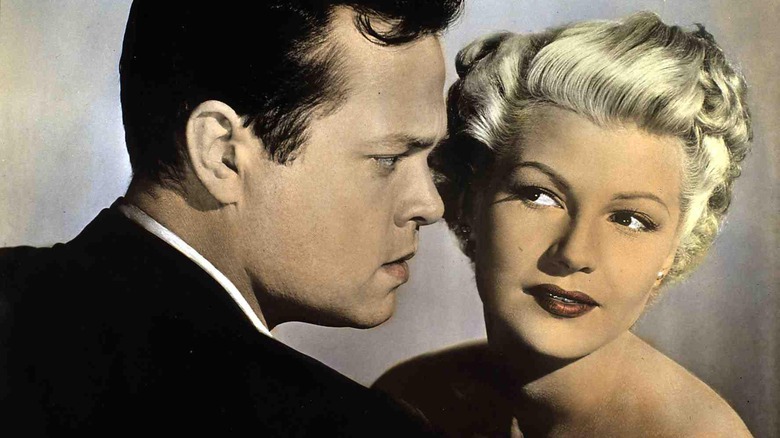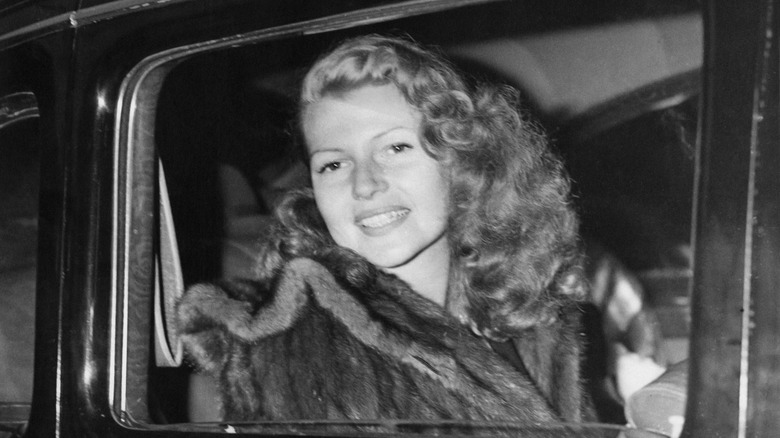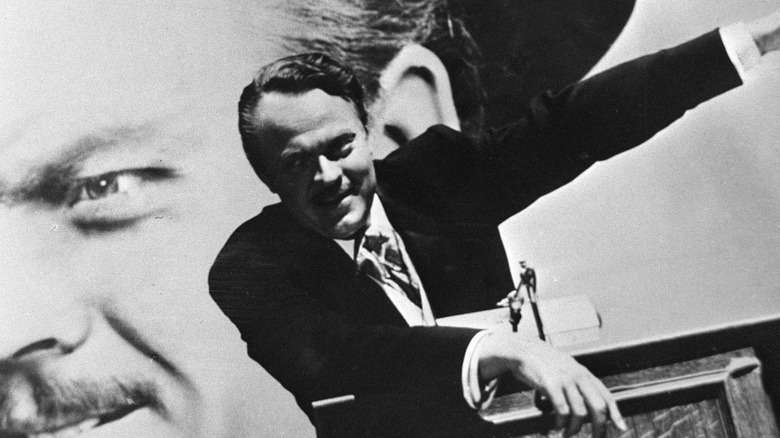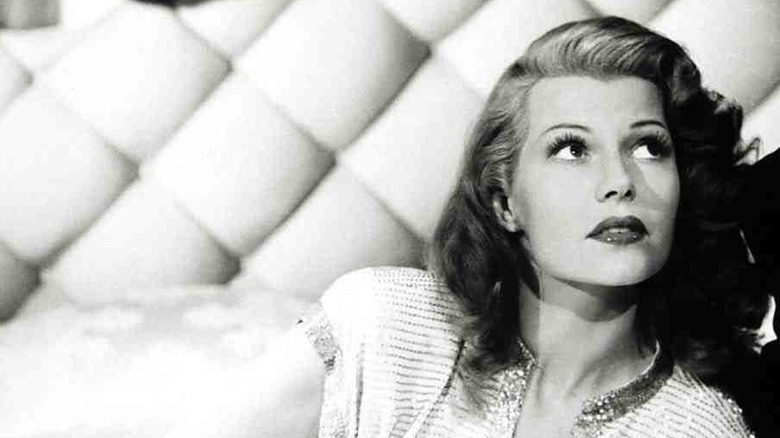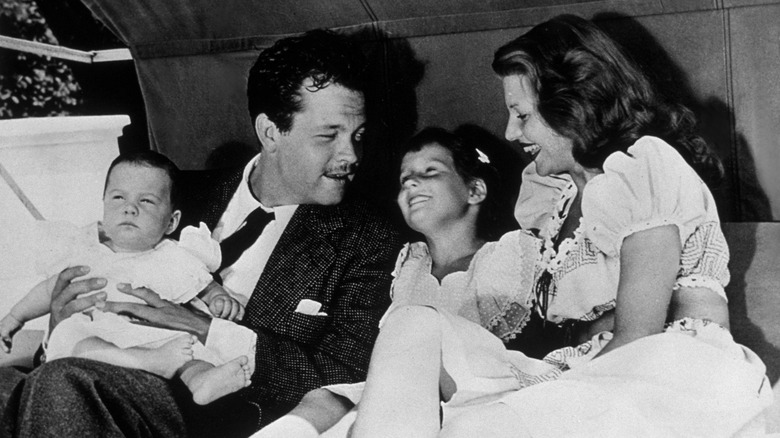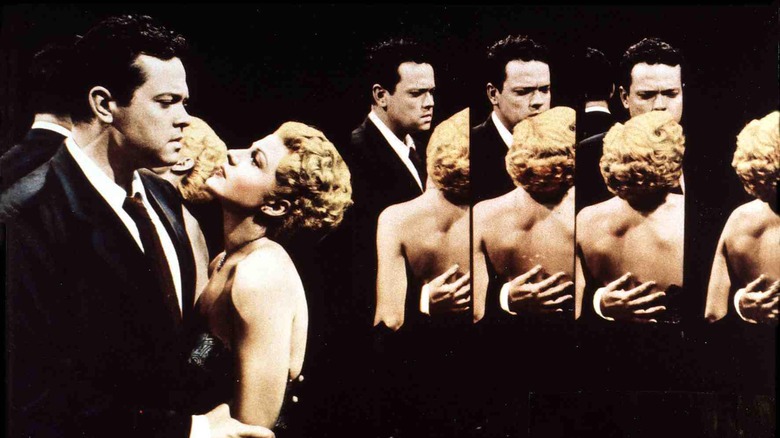The Truth About Rita Hayworth's Relationship With Orson Welles
You'd be hard-pressed to find a bigger Hollywood power couple in the early to mid-1940s than the dynamic duo of Rita Hayworth and Orson Welles. The two married quickly and unexpectedly in 1943, according to The Hollywood Reporter, and their spur-of-the-moment nuptials drew a crowd of photographers.
Their relationship didn't last too long and by 1947 it was over. However, at the time it gave Hayworth a slight break from her troubled life before meeting Welles, though their marriage wasn't without its issues, including Welles' infidelity (via Vanity Fair).
The two had very different upbringings and by the 1940s, both of them were navigating their careers and the obstacles that came with them. Hayworth was trying to stay on top as one of Hollywood's most popular leading ladies, while Welles was burdened with the task of trying to recapture the magic of his 1941 masterpiece "Citizen Kane," something that plagued him his entire career. Still, the two shared the screen toward the end of their relationship when they co-starred together in the noir classic, "The Lady From Shanghai."
Rita Hayworth's early life and career
Rita Hayworth was born on October 17, 1918, in New York City to a pair of former vaudeville performers. Hayworth's real name was Margarita Carmen Cansino (via Biography). As a child, Hayworth was known to be a kind, sweet girl, but a poor student, who eventually came to develop a strong dancing ability like her parents. Her father had performed an act with his sister, billed as the Dancing Cansinos. Recognizing his daughter's ability, Eduardo Cansino decided to revive his old dance act with his daughter as his new partner. Unfortunately, this was just the first instance of men in Hayworth's life using her and her career for their own financial gain. Hayworth would later say that her father abused her (via Vanity Fair).
Hayworth was discovered by a producer for the Fox Film Company when she was just 16 years old and was performing with her father. A few years later, Hayworth married her first husband, Edward Judson, who was almost twice her age and served as her manager. He was the one who recommended that she take the last name, Hayworth.
The move worked, and Hayworth was on her way to becoming a star. However, according to the 1989 Hayworth biography, "If This Was Happiness" by Barbara Leaming, she would later say about the marriage that "I married him for love, but he married me for an investment. For five years he treated me as if I had no mind or soul of my own."
Orson Welles' early life and career
Orson Welles was born on May 6, 1915, in Kenosha, Wisconsin, and while he had some performance ability in his blood — his mother was a concert pianist — that's about where the similarities to Hayworth's childhood end. The Welles family was wealthy because his father, Richard, had invented a carbide lamp for bicycles. However, his parents divorced when he was young, and by the time Welles was just 13 years old, both of his parents were dead. At 15, he was enrolled in a school that allowed him to discover theater. After his schooling, he took some money left over from his inheritance and traveled to Ireland, where he put on plays.
Welles made his Broadway debut at just 19 years old, and by age 21 he had helped start the Mercury Theatre, perhaps most well-known from the radio program "The Mercury Theatre on the Air." That show is best remembered for its 1939 Halloween episode that was an adaptation of H.G. Welles' "War of the Worlds" which grabbed listeners' attention by using a format that resembled a news broadcast, which some listeners thought was real (via Biography). The broadcast is still considered legendary, and it was enough for Hollywood producers to realize that Welles was a rising star. He signed a two-picture deal with RKO studios. The first of the two films was "Citizen Kane," which was released in 1941 when he was just 26 years old.
Rita Hayworth: the femme-fatale
The femme fatale was a common trope in noir films, and Rita Hayworth became one of the most sought-after actresses for that kind of role. While she became synonymous with the roles she played — beautiful, assertive, and sometimes dangerous women — Hayworth was completely the opposite offscreen, something that led to headaches in her personal life. Hayworth was married five times and had relationships with even more notable men, like billionaire Howard Hughes and actor Kirk Douglas. The problem for her was that many of the men who came into her life were drawn to her on-screen persona, but that just wasn't her.
"The whole wicked Gilda figure" — Gilda was the character she played in the film of the same name — "was absolutely false. It was a total impersonation — like Lon Chaney or something," Welles later said.
Still, it was that same image that initially got his attention. While shooting a film in Brazil Welles saw a photo spread of Hayworth in Life magazine (via Vanity Fair). Welles decided then and there that when he returned to the United States he was going to meet Hayworth.
Welles and Hayworth became an item
In 1942, Welles and his friend, actor Joseph Cotton, were putting together "The Mercury Wonder Show" when he had an idea. The production was a magic show designed to entertain soldiers during World War II. Welles realized he could meet Hayworth by casting her as the magician's assistant (he was the magician). She agreed and was even sawed in half at each show until the head of Columbia Pictures, where she was signed, told her to stop (via The Hollywood Reporter). Still, it was enough for the two to get to know each other, and Hayworth would later call Welles "the great love of my life." According to Vanity Fair, Hayworth enjoyed palling around with Welles and his compatriots from the Mercury Theatre.
By 1943, they were ready to be married, and on Hayworth's lunch break from shooting the film "Cover Girl," they ran down to the courthouse and made it official, with crowds of paparazzi waiting outside. Hayworth's past relationships had made her think that the best path to a healthy relationship was to please her partner by being whoever they wanted her to be, and this apparently continued with Welles, though not in as much of a destructive way. Welles was famous for his intelligence, so she read the same books that he did and supported him as he mulled the possibility of a jump into politics, a move that would have mirrored his famous character, Charles Foster Kane.
The end of their relationship
The marriage between Hayworth and Welles didn't last long. By 1946 they were separated, when Hayworth moved into her home with the couple's daughter Rebecca, according to The Hollywood Reporter. Welles engaged in an affair with Judy Garland and was known to have frequently visited sex workers at the time (via Vanity Fair).
However, they were still legally married and appeared together in "The Lady From Shanghai," a classic film probably best remembered for its "mirror scene" ending, in which a gunfight unfolds inside a hall of mirrors (on YouTube). Some have noted the possible symbolism that in the film — which Welles also wrote and directed — Hayworth's trademark long, red hair had been cut and dyed blonde.
In 1947, Welles and Hayworth officially divorced. Barbara Leaming wrote in "If This Was Happiness" that Hayworth later told Welles, "You know the only happiness I've ever had in my life has been with you." This statement allegedly filled him with immense guilt for how he had treated their marriage.
